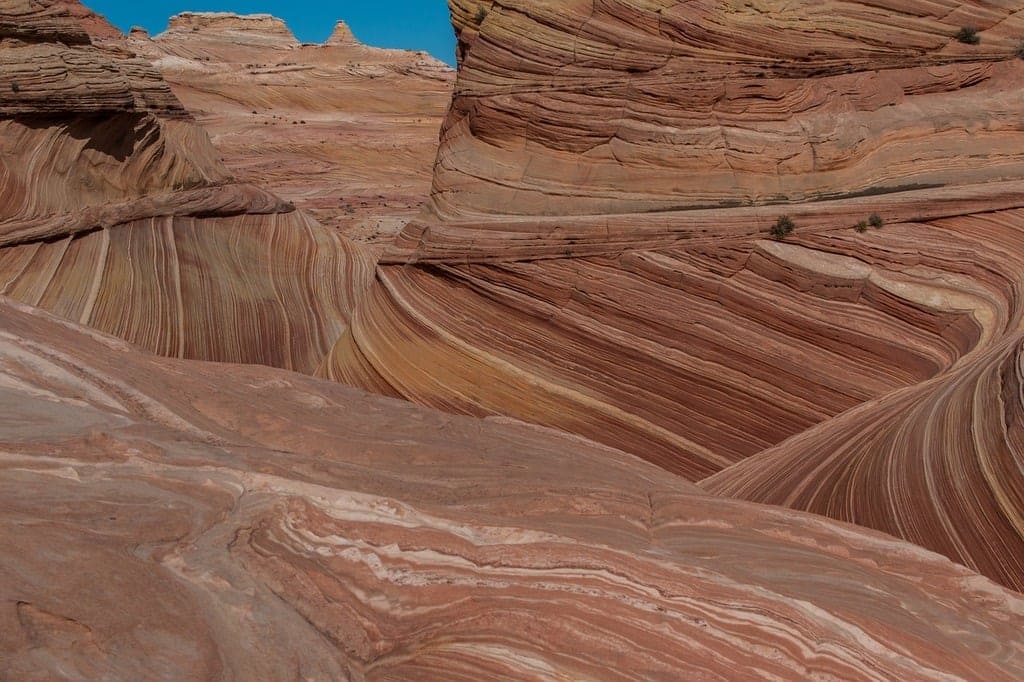
Sandstone, as the name implies, is a rock formed from sand. But the story of sandstone is not straightforward. From the grandiose cliffs to the subtle hues of deserts, sandstone’s story is as intricate as the grands of sand that make it. Let’s try to understand this versatile rock, unraveling its secrets from formation to its myriad uses.
1. What is Sandstone?
Sandstone is a type of sedimentary rock and one of Earth’s most ubiquitous rocks. Forming a significant part of the Earth’s crust, it comprises about 20-25% of all sedimentary rocks. Its creation begins with sand—tiny fragments of eroded minerals and rocks—often dominated by quartz and feldspar, the two minerals most resilient to the relentless forces of weathering and erosion.
Quartz and feldspar endow sandstone with its notable durability and resistance to the harsh elements at the Earth’s surface. This resilience is a direct consequence of the enduring nature of these minerals, which can withstand long periods of exposure to water, wind, and chemical interactions.
Visually, sandstone presents a stunning array of colors, shapes, and textures, making it a geological canvas that narrates the Earth’s history. Its colors can range from subtle whites and grays to bold reds and yellows, often influenced by the presence of other minerals and organic materials. For instance, iron oxides can impart a reddish hue, while carbonaceous materials may lead to darker tones.
The grain size of sandstone varies but typically falls within the range of 0.0625 to 2 mm, classifying it as a medium-grained sedimentary rock. This granular texture not only defines its appearance but also its properties. The spaces between these grains play a crucial role in how sandstone behaves, especially in terms of porosity and permeability, making it a vital resource for water and hydrocarbon reservoirs.
2. Formation and Composition of Sandstone
Sandstone’s journey from loose grains to solid rock begins with the weathering and erosion of pre-existing rocks. As rocks break down, they release individual mineral grains, predominantly quartz and feldspar, which have exceptional resistance to weathering. This resistance stems from the strong internal structure of these minerals, allowing them to endure where others would dissolve or crumble.
Once these grains are freed, they embark on a journey, transported by rivers, wind, or waves, moving from their source to new locations. This journey is not merely a physical relocation but also a process of sorting and grading. The grains are sifted by the elements, with the lighter ones often carried farther than their heavier counterparts. This natural sorting leads to the distinctive uniformity in grain size that is a hallmark of many sandstone deposits.
Upon reaching their final destination, the grains settle and accumulate in layers. These depositional environments vary widely, from river beds and beaches to deserts and ocean floors. The environment plays a pivotal role in determining the characteristics of the forming sandstone. For example, river deposits often lead to well-rounded, well-sorted sand grains, while wind-blown desert sands tend to be very well-sorted and rounded.
As more material accumulates, the weight of the overlying sediments exerts pressure on the lower layers, compacting them. This compaction is the first step in the transformation from loose sand to rock. Subsequently, diagenesis, a process that includes further compaction and cementation, occurs. During cementation, minerals like silica, calcium carbonate, or iron oxides precipitate from groundwater, filling the spaces between the sand grains and binding them together.

The composition of sandstone is largely defined by its framework grains. Yet again, these are predominantly quartz and feldspar. Quartz, being highly resistant to weathering, is often the dominant component. Feldspar, although less resistant than quartz, is abundant in the Earth’s crust and thus a common component of sandstone.
In addition to these, sandstone may contain lithic fragments—pieces of pre-existing rock—and accessory minerals like micas, olivine, and pyroxene, which can provide clues about the sandstone’s origin and history.
The rock matrix, or the finer-grained material that occupies the spaces between the framework grains, also contributes to the composition of sandstone. This matrix can range from being almost non-existent in clean, well-sorted sandstones to being abundant in wackes, where the matrix can make up a significant portion of the rock.
Through this intricate process of weathering, transportation, deposition, and diagenesis, sandstone is formed—a rock that not only reveals the history of its own creation but also offers insights into the past environments and climates of the Earth.
3. Types of Sandstone
There are several geological types of sandstone, each reflecting the conditions of its formation:
- Quartz Arenites: Rich in quartz, these are the most mature, having undergone extensive recycling and weathering.
- Feldspathic Arenites: Containing more feldspar than quartz, these sandstones are indicative of a less mature origin.
- Lithic Arenites: Characterized by a high content of rock fragments, pointing to a rapid erosion and deposition.
- Wackes: These have a significant amount of matrix material mixed with the sand grains.
Let’s take a closer look at each type of sandstone in more detail.
Quartz Arenites
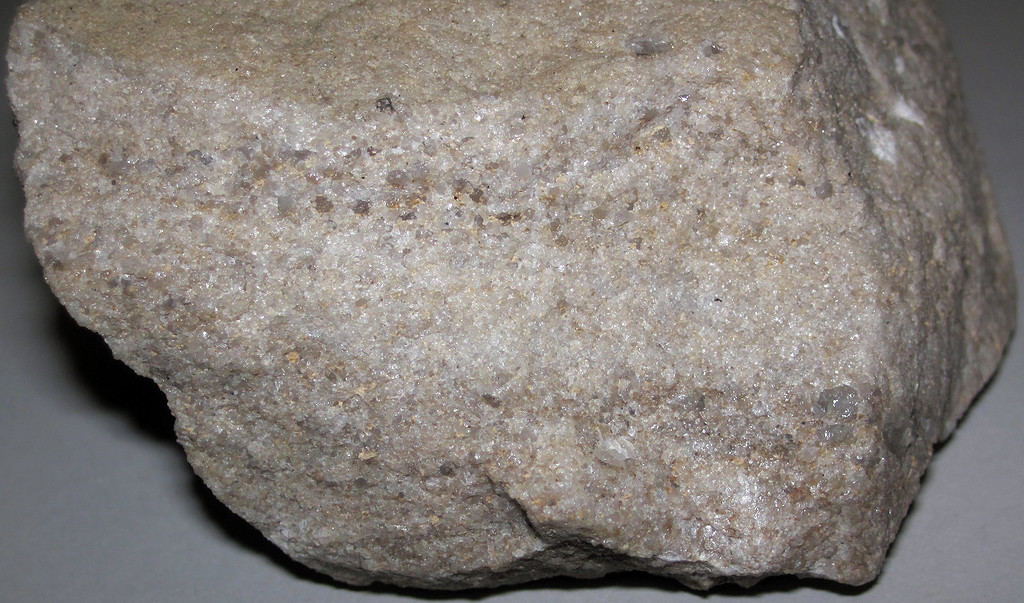
Quartz arenites are the epitome of mature sandstone, composed almost entirely of quartz grains. These sandstones have undergone extensive weathering and transportation, which strips away less resistant minerals and rock fragments. The high purity of quartz in these rocks signifies prolonged exposure to erosional processes, often in stable continental settings. Quartz arenites are typically white to light gray, signifying their high quartz content and minimal impurities.
Feldspathic Arenites
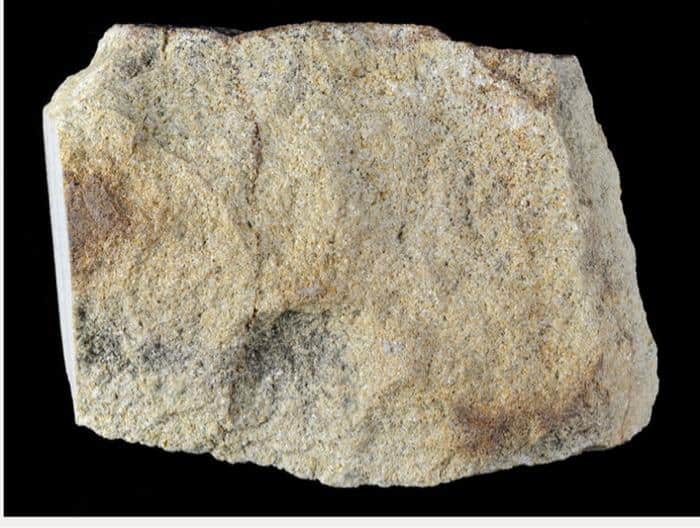
Feldspathic arenites, also known as arkose, are less mature than quartz arenites and contain a significant proportion of feldspar grains, often exceeding 25%. These sandstones usually form in environments close to their source rocks, particularly granitic or metamorphic terrains, where rapid erosion prevents extensive weathering and transport. The presence of feldspar indicates that these sandstones have not traveled far from their origin, preserving the feldspar’s integrity.
Lithic Arenites
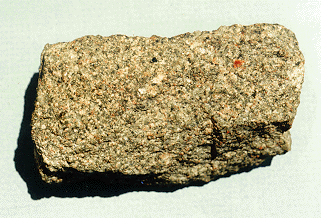
Lithic arenites are characterized by a high content of rock fragments, including volcanic, metamorphic, or sedimentary pieces. These fragments suggest a rapid deposition, likely near mountainous or tectonically active regions where a variety of rock types are quickly eroded and deposited. Lithic arenites often reveal a complex geological history and are typically associated with more immature, texturally diverse sedimentary environments.
Wackes

Wackes (or graywackes) are sandstones with a significant amount of matrix material, comprising over 15% of the rock. This matrix, often clay or silt-sized particles, fills the spaces between the sand grains. Wackes indicate rapid deposition in a relatively unstable environment, such as submarine settings, where there is insufficient time for the complete washing away of finer particles. Their composition can vary, but they generally contain a mix of quartz, feldspar, and lithic fragments.
Other Notable Varieties
In addition to these primary types, there are other specialized varieties of sandstone:
- Greywacke: A heterogeneous mix of rock fragments and angular grains, often found in deep-sea environments and indicating high-energy deposition conditions.
- Ironstone: Rich in iron oxides, giving it a distinct reddish or rusty color, often indicative of specific environmental conditions that favored the precipitation of iron minerals.
4. Characteristics of Sandstone
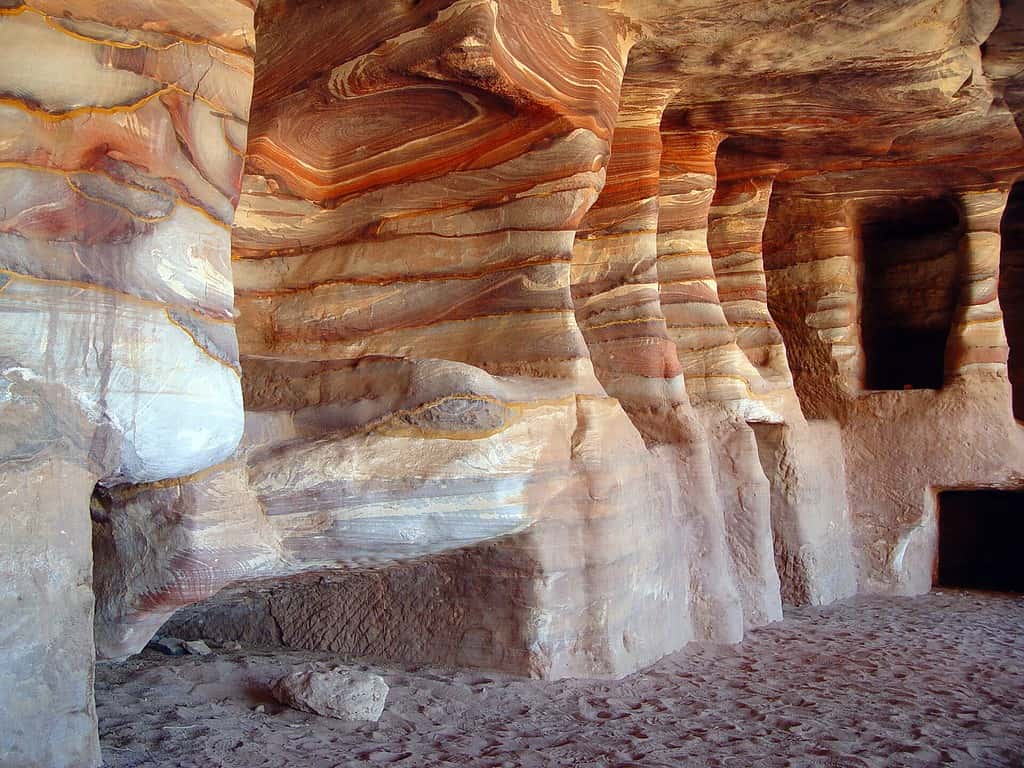
Sandstone is distinguishable by its grainy texture and often stratified appearance. Its porosity makes it an excellent reservoir for water and hydrocarbons. The color spectrum of sandstone, ranging from whites and grays to reds and browns, is influenced by the impurities and iron compounds within the grains.
Texture and Grain Size
The texture of sandstone is primarily defined by its grain size, which typically ranges from 0.0625 to 2 mm. This size categorizes it as a medium-grained sedimentary rock. The grains in sandstone are often visibly discernible, giving it a gritty texture. The degree of sorting and rounding of these grains can vary, indicating the energy and distance of transport. Well-sorted and rounded grains suggest long-distance transport by water or wind, while poorly sorted, angular grains indicate a nearby source and rapid deposition.
Color Variations
One of the most striking features of sandstone is its wide range of colors. These hues are not just aesthetically pleasing but are also informative about the conditions under which the sandstone formed. Common colors include tan, yellow, red, gray, and white. Iron oxides can impart red, brown, or yellow colors, while the presence of organic material can lead to darker shades. The purity of quartz sandstones often results in lighter colors like white or pale gray.
Porosity and Permeability
Sandstone is notable for its porosity – the percentage of void space between grains. This characteristic makes it an excellent reservoir for fluids, such as water, oil, and natural gas. Permeability, which is the capacity of a rock to transmit fluids through it, is another significant feature. The high porosity and permeability of sandstone are crucial in geological and environmental studies, particularly in understanding groundwater flow and hydrocarbon reservoirs.
Strength and Durability
While the strength of sandstone can vary, it is generally considered a durable building material. Its strength largely depends on the cementing material (such as silica, calcite, or iron oxides) and the compactness of the grains. Sandstones with a higher quartz content are typically harder and more resistant to weathering, making them suitable for various construction purposes.
Sedimentary Structures
Sandstones often exhibit distinctive sedimentary structures which can include bedding or layering, cross-bedding, ripple marks, and mud cracks. These features provide valuable insights into the depositional environment and the conditions prevailing at the time of formation. For example, cross-bedding indicates deposition by wind or water currents, while ripple marks can point to shallow water environments.
Mineralogical Composition
Though primarily composed of quartz and feldspar, sandstone can also contain other minerals like micas, clay minerals, and carbonate minerals. The mineralogical composition can affect the weathering behavior and mechanical properties of the sandstone. For instance, sandstones with a significant clay mineral content may be less resistant to weathering.
Reactivity to Acid
Some types of sandstone react with acid. This characteristic is particularly notable in sandstones with a calcite cement, which will effervesce in the presence of dilute hydrochloric acid. This reaction can be a handy field test for identifying certain types of sandstone.
5. How to Identify Sandstone
Identifying sandstone involves looking for its hallmark grainy texture, where individual sand grains are visible to the naked eye. Its relative hardness and resistance to scratching by a metal object (due to the presence of quartz) are also indicative. Additionally, its color variations can be a helpful identification marker.
Visual Inspection
- Grainy Texture: One of the most distinctive features of sandstone is its grainy texture. You can often see and feel the individual sand grains with the naked eye or with a hand lens. This texture is markedly different from the smoothness of limestone or the crystalline appearance of granite.
- Color Variations: Sandstone comes in a range of colors, including tan, yellow, red, gray, pink, white, and black. These colors can give hints about the mineral content and the conditions under which the sandstone formed.
Physical Tests
- Hardness Test: While sandstone varies in hardness, it generally resists scratching with a metal object like a knife. This test can help differentiate it from softer sedimentary rocks like shale.
- Porosity Test: Sandstone is typically porous, with noticeable spaces between the grains. This can be tested by observing how water absorbs into the rock. Water tends to soak into sandstone more readily compared to less porous rocks.
- Acid Reaction Test: Some sandstones, particularly those with calcite cement, will react with dilute hydrochloric acid, producing fizz or bubbles. This reaction can help in distinguishing calcareous sandstone from other types.
6. Uses of Sandstone
Sandstone’s utility spans several areas:
Construction and Architectural Applications
- Building Material: Sandstone has been a popular building material for centuries due to its durability and ease of working. It is used in the construction of buildings, bridges, pavements, and other structures. The natural beauty and range of colors also make it a desirable choice for exterior cladding and landscaping.
- Flooring and Paving: Due to its resistance to wear and ability to withstand varying weather conditions, sandstone is commonly used for paving patios, garden paths, and outdoor sitting areas. Its natural slip-resistant texture makes it a safe choice for flooring.
Art and Sculpture

- Sculpture Material: Artists and sculptors often choose sandstone for its workability and aesthetic qualities. It can be carved into intricate designs, making it suitable for statues, monuments, and decorative elements in architecture.
- Reliefs and Carvings: The softer varieties of sandstone are particularly suited for detailed reliefs and carvings, used in historical buildings, temples, and modern art pieces.
Landscaping
- Garden Design: Sandstone’s natural appearance and variety of colors make it a popular choice in landscape design. It is used for garden edging, retaining walls, water features, and as decorative elements in gardens and outdoor spaces.
Industrial Uses
- Grindstones: The coarser varieties of sandstone are used to make grindstones for sharpening blades and other tools. Its abrasive qualities make it suitable for grinding and polishing.
- Filtering Systems: Due to its porosity, sandstone can act as a natural filter, purifying water by trapping particulates. This property is harnessed in some water filtration systems.
7. Conclusions
Sandstone is a common sedimentary rock, and it carries within a lot of information. It’s almost like a record keeper of Earth’s geological and climatic history. Its varied types, characteristics, and widespread use in human civilization underscore its significance. As we continue to explore and utilize this remarkable sedimentary rock, we gain more than just a material for construction and art; we gain insights into the very planet we call home.


